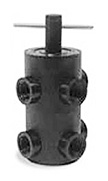 The ball valve hasn’t really evolved much since it was first invented in the 1950’s. Reaching the mature stage of its lifecycle, enhancements leveled off over time and it remained fairly constant for years. However, more could be done with traditional ball valve mechanisms if its inherent limitations were lifted and an alternative could replace it without disruption.
The ball valve hasn’t really evolved much since it was first invented in the 1950’s. Reaching the mature stage of its lifecycle, enhancements leveled off over time and it remained fairly constant for years. However, more could be done with traditional ball valve mechanisms if its inherent limitations were lifted and an alternative could replace it without disruption.
Today there is a breadth of modernized flow solutions that offer greater longevity, effectiveness, control, material varieties, flow pattern selection, and design. Considering the advancements made to flow mechanisms, it’s important to be aware of all your options before replacing your next traditional ball valve.
What Are Ball Valve Alternatives?
Ball valve alternatives work exactly the same as traditional ball valves. They contain an elliptic shaped seal to control the flow of liquid that passes through and are applicable in manual, electric or pneumatically actuated systems. The primary differences with non-standard valves are in their design, composition, and overall efficiency, depending on the part’s usage. Alternative ball valves come in a broader array of types, and material selection. Unlike traditional ball valves, they can also be stacked allowing the operation of multiple valves in a single unit.
When Should Ball Valve Alternatives Be Considered?
Depending on your requirements, ball valve alternatives could potentially meet a spec beyond a traditional ball valve’s capability, in mission critical situations, or when tasked with finding a more efficient, effective, and better means of achieving an end goal. If you are seeking any of the five descriptions below, you should consider a ball valve alternative.
1. Specific Flow Pattern
Perhaps the need for a ball valve replacement results from incompatibility … or simply it’s not a fit. Rather than messing with your pipelines to work around the rigid contour of the traditional valve, simply choose a ball valve replacement that syncs with the requirement. From 2-way to 5-way flow configurations, where dozens of flow pattern options exist to simplify any design issues.
2. Wetted Material Can Change for Custom Applications???
Say an engineer makes a request of a valve that simply does not exist, standard or not. No need to fear, for the manufacturers of alternatives can customize valves to suit any application. The wetted materials can be modified to serve specific applications.
3. Stronger, Sturdier Material
Ball valve alternatives work effectively because they are built simply and efficiently. Non-standard porting with excellent chemical and inert materials will extend its longevity and minimize all that goes into its replacement. While simplicity and design serve for functionality, the longevity of the product relies heavily on the valve’s composition. Choose a product where materials will not easily deteriorate or breakdown.
4. Simpler Design, Longer Use
Sometimes the right fit is all you need. The proper valve will ensure a more compact design for your application as well as increasing its longevity with material selections.
5. Space Constraints
When valves are stacked, it can help resolve space design limitations, and cost reduction. Using “Stack Valves”, you can actuate multiple valves with a single actuator.
Thanks to ball valve alternatives, reliance no longer exists on rigid, often less-than adequate traditional valves for every application. Non-standard valves allow the more savvy engineers to remain open and intricate with their designs without worrying whether they will find a correctly configured valve.